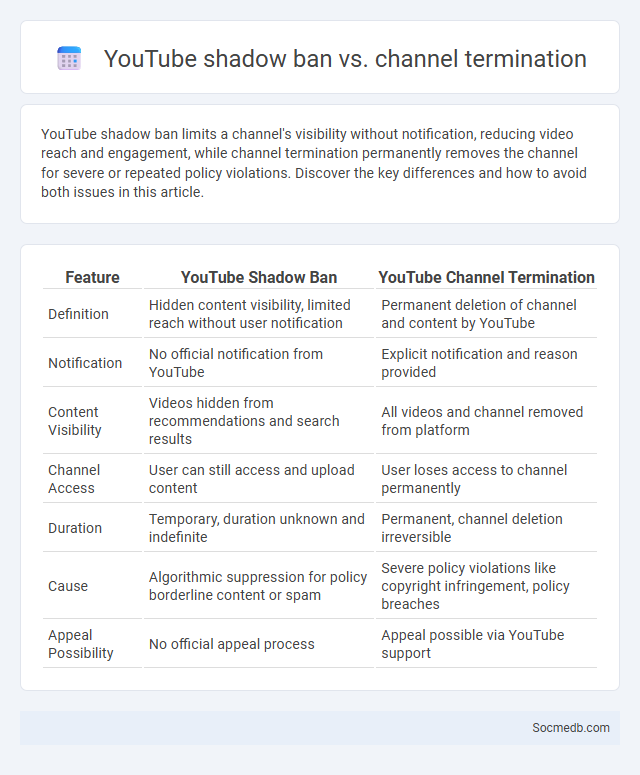
Photo illustration: YouTube shadow ban vs channel termination
YouTube shadow ban limits a channel's visibility without notification, reducing video reach and engagement, while channel termination permanently removes the channel for severe or repeated policy violations. Discover the key differences and how to avoid both issues in this article.
Table of Comparison
| Feature | YouTube Shadow Ban | YouTube Channel Termination |
|---|---|---|
| Definition | Hidden content visibility, limited reach without user notification | Permanent deletion of channel and content by YouTube |
| Notification | No official notification from YouTube | Explicit notification and reason provided |
| Content Visibility | Videos hidden from recommendations and search results | All videos and channel removed from platform |
| Channel Access | User can still access and upload content | User loses access to channel permanently |
| Duration | Temporary, duration unknown and indefinite | Permanent, channel deletion irreversible |
| Cause | Algorithmic suppression for policy borderline content or spam | Severe policy violations like copyright infringement, policy breaches |
| Appeal Possibility | No official appeal process | Appeal possible via YouTube support |
Understanding YouTube Shadow Ban
YouTube shadow ban limits the visibility of a user's videos without notifying them, reducing video reach and engagement by restricting content from appearing in search results and recommendations. This often results from violating community guidelines, using spammy tags, or engaging in suspicious activities that trigger YouTube's algorithm. Understanding these penalties helps creators adjust content strategies to maintain channel health and avoid organic growth suppression.
What Is Channel Termination on YouTube?
Channel termination on YouTube refers to the permanent removal of a user's channel due to violations of YouTube's Community Guidelines or Terms of Service, such as repeated copyright infringement or harmful content. This action results in the loss of all videos, comments, and subscribers, effectively ending the creator's presence on the platform. YouTube enforces termination to maintain a safe and compliant community environment for all users.
Defining Shadow Banning: Beyond YouTube
Shadow banning refers to the covert restriction of a user's online visibility without explicit notification, often used to limit content reach on platforms like Instagram, Twitter, or TikTok. This practice reduces engagement by making posts less discoverable through search or hashtags, effectively suppressing content without account suspension. Understanding shadow banning is essential for managing your social media presence and ensuring your content maintains its intended audience reach.
Key Differences: Shadow Ban vs Channel Termination
Shadow ban limits Your social media reach by hiding posts without notification, reducing visibility and engagement subtly over time. Channel termination permanently removes Your account or page, erasing all content and cutting off access immediately. Understanding these key differences helps You navigate platform rules and address content restrictions effectively.
How to Recognize a YouTube Shadow Ban
You can recognize a YouTube shadow ban by a significant drop in views, engagement, and subscriber growth without any notifications or clear reasons from the platform. Check if your videos are not appearing in search results, recommendations, or subscriber feeds despite consistent posting patterns. Monitoring analytics for sudden, unexplained performance changes helps you identify potential shadow ban situations and adjust your content strategy accordingly.
Common Reasons for YouTube Channel Termination
YouTube channel termination often occurs due to repeated violations of community guidelines, including copyright infringement, harmful content, or spam practices. Consistent breaches of YouTube's policies on hate speech, harassment, or misinformation can result in permanent removal of your channel. Protecting your channel requires adherence to YouTube's specific rules to avoid penalties and maintain content visibility.
Impacts of Shadow Banning on Content Creators
Shadow banning significantly affects content creators by limiting their reach and engagement without clear notification, resulting in decreased visibility across key platforms like Instagram, TikTok, and Twitter. This covert restriction hinders Your ability to grow an authentic audience and monetize content effectively, creating frustration and uncertainty about compliance with platform policies. Understanding shadow banning mechanisms is essential for adapting content strategies and maintaining online influence despite algorithmic limitations.
Prevention Strategies: Avoiding Bans on YouTube
Implement clear community guidelines aligned with YouTube's policies to prevent account bans and content removal. Regularly monitor content for compliance using automated tools and human review systems to detect and address potential violations promptly. Engage with YouTube support channels and education resources to stay updated on policy changes and best practices for content creation.
Recovering from Shadow Ban or Channel Termination
Recovering from a social media shadow ban involves identifying content that violates platform guidelines and promptly removing or editing it to comply with community standards. Engaging consistently with the audience through legitimate interactions and diversifying posting times can help signal account authenticity to algorithms. For channel termination, submitting a detailed appeal with evidence of compliance and rectification efforts increases chances of reinstatement, while simultaneously establishing backup accounts safeguards against future disruptions.
Alternative Platforms and Future Trends
Alternative social media platforms like Mastodon, Diaspora, and Minds are gaining traction by prioritizing user privacy, decentralized networks, and open-source frameworks that counter traditional centralized giants like Facebook and Twitter. Emerging trends highlight the integration of blockchain technology for enhanced data security, augmented reality (AR) for immersive user experiences, and artificial intelligence-driven content moderation to foster safer online communities. The future landscape of social media points towards increased personalization, cross-platform interoperability, and stringent privacy regulations shaping user engagement and platform evolution.
 socmedb.com
socmedb.com